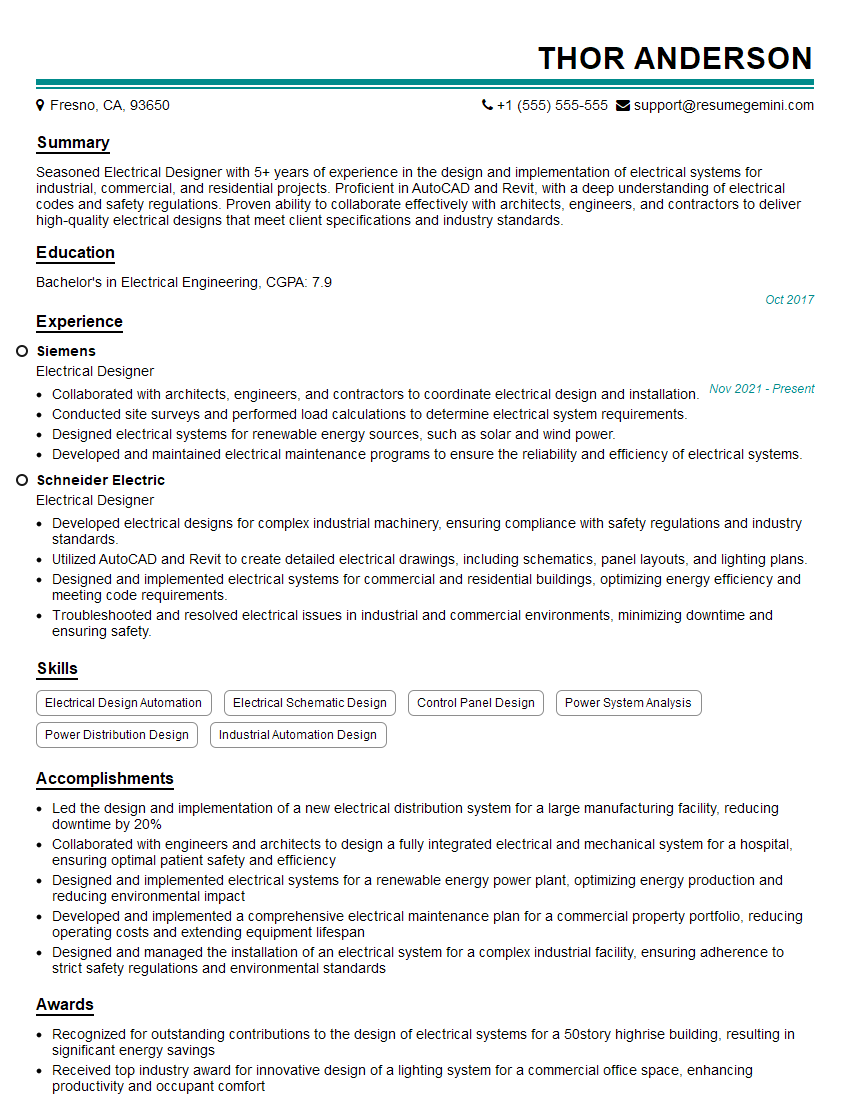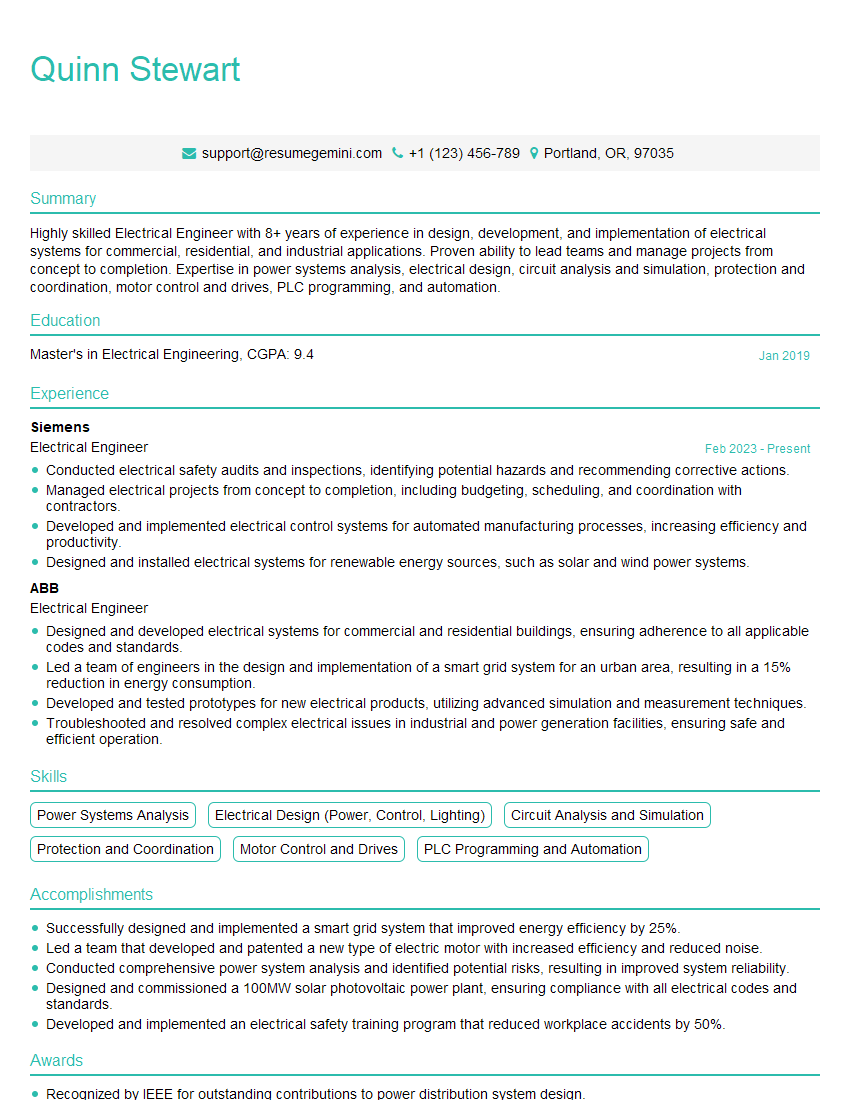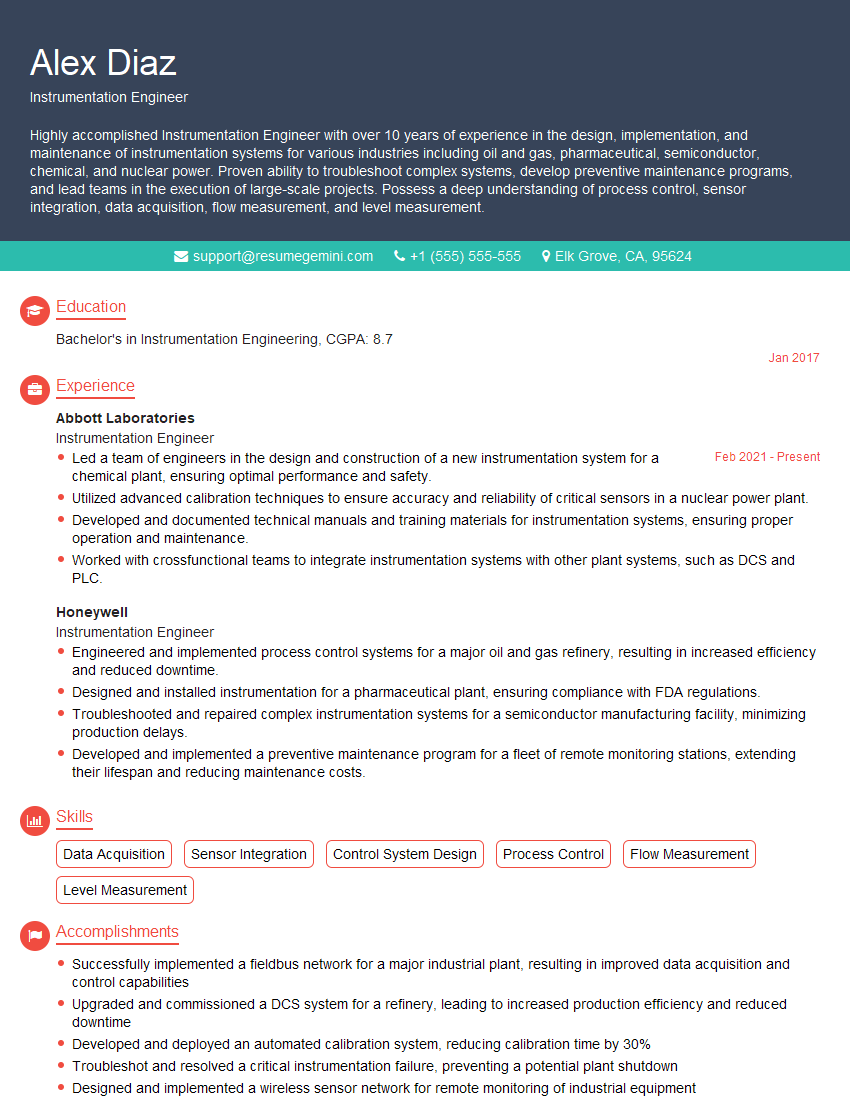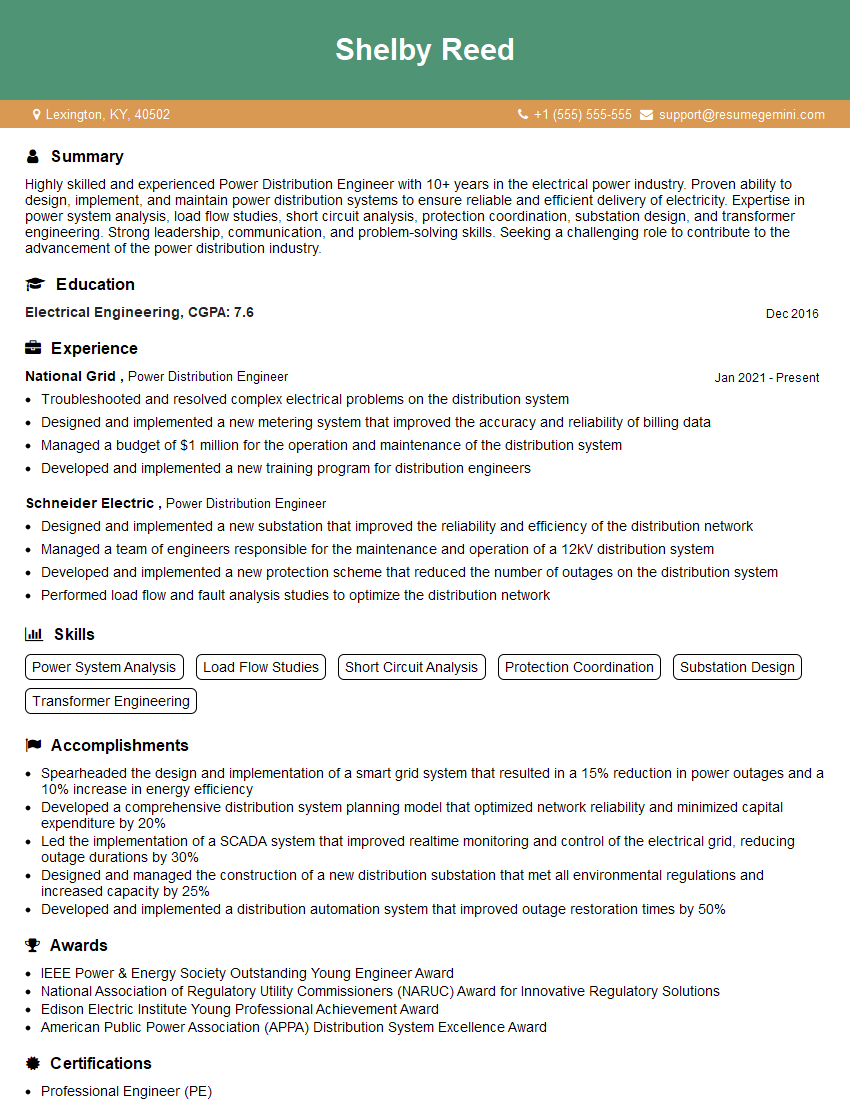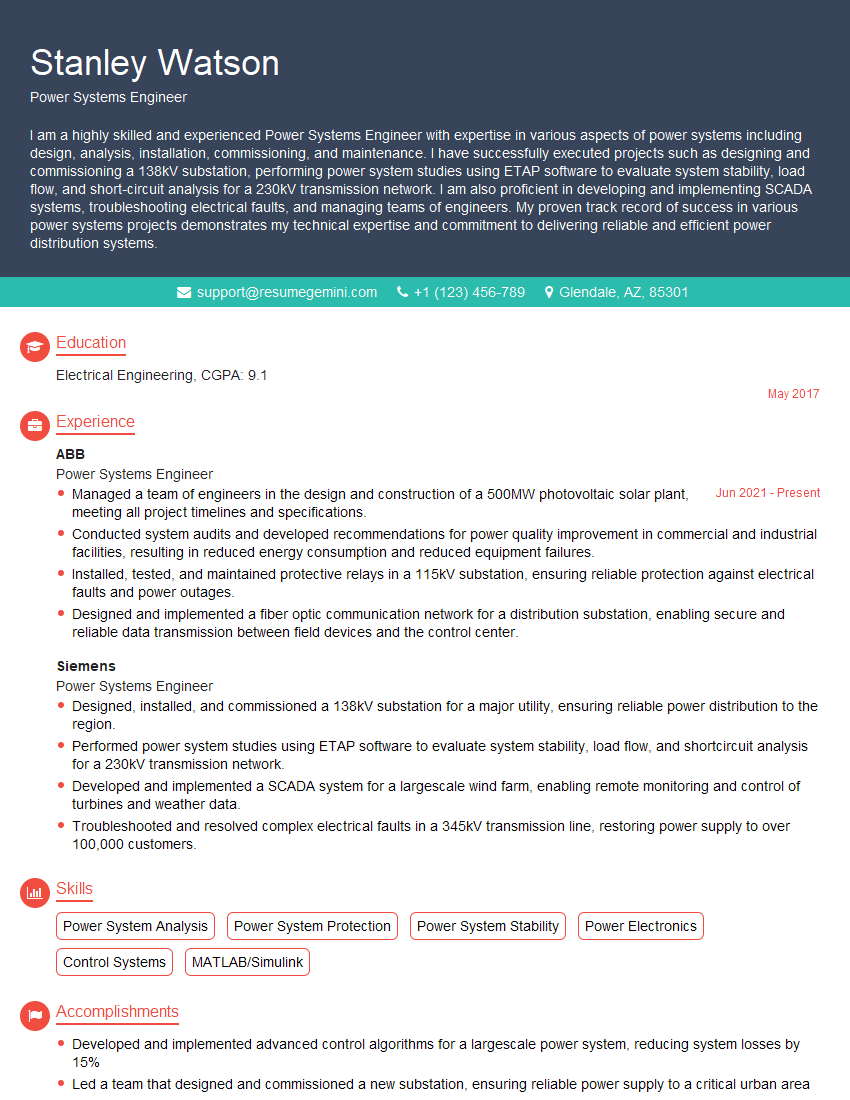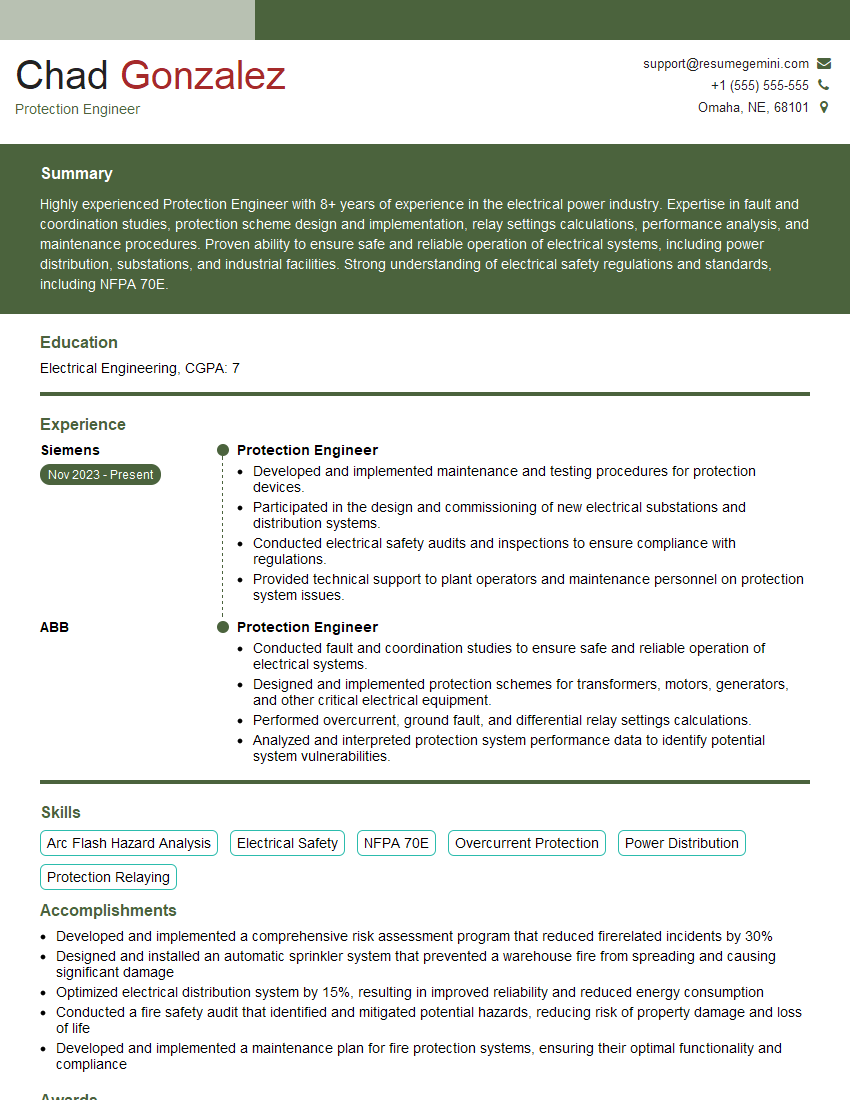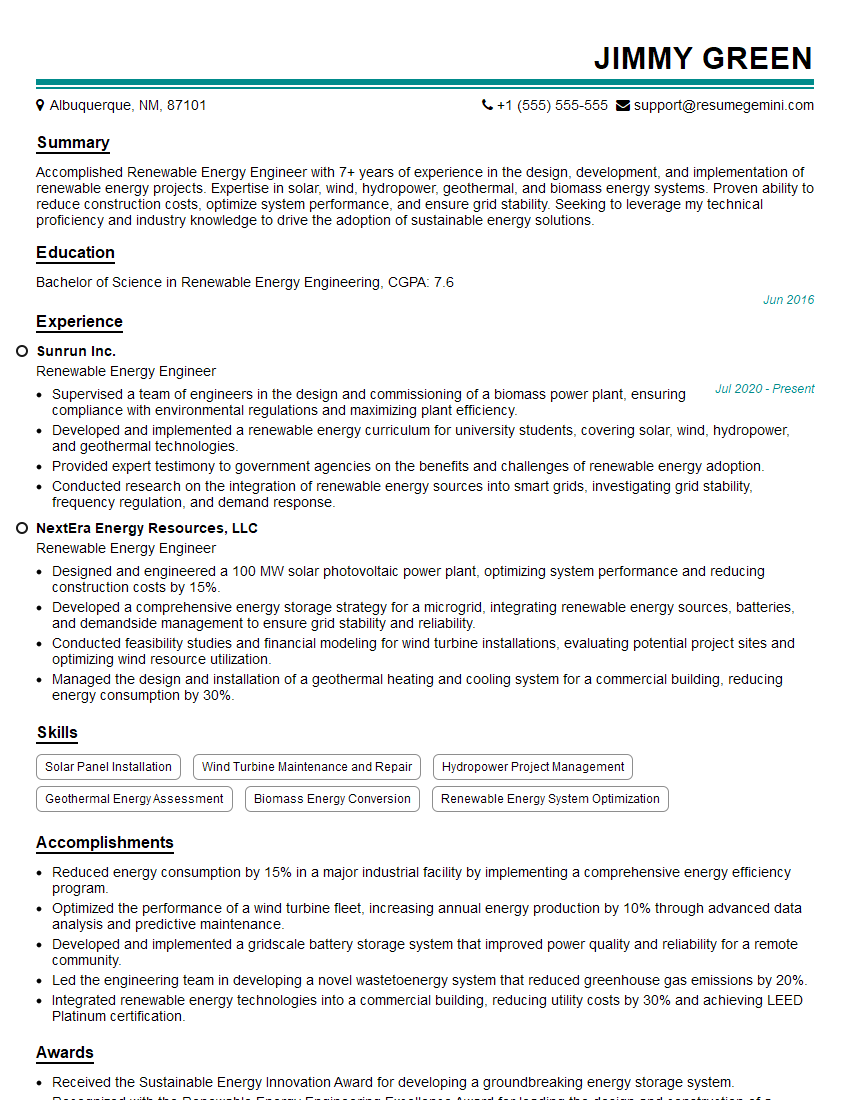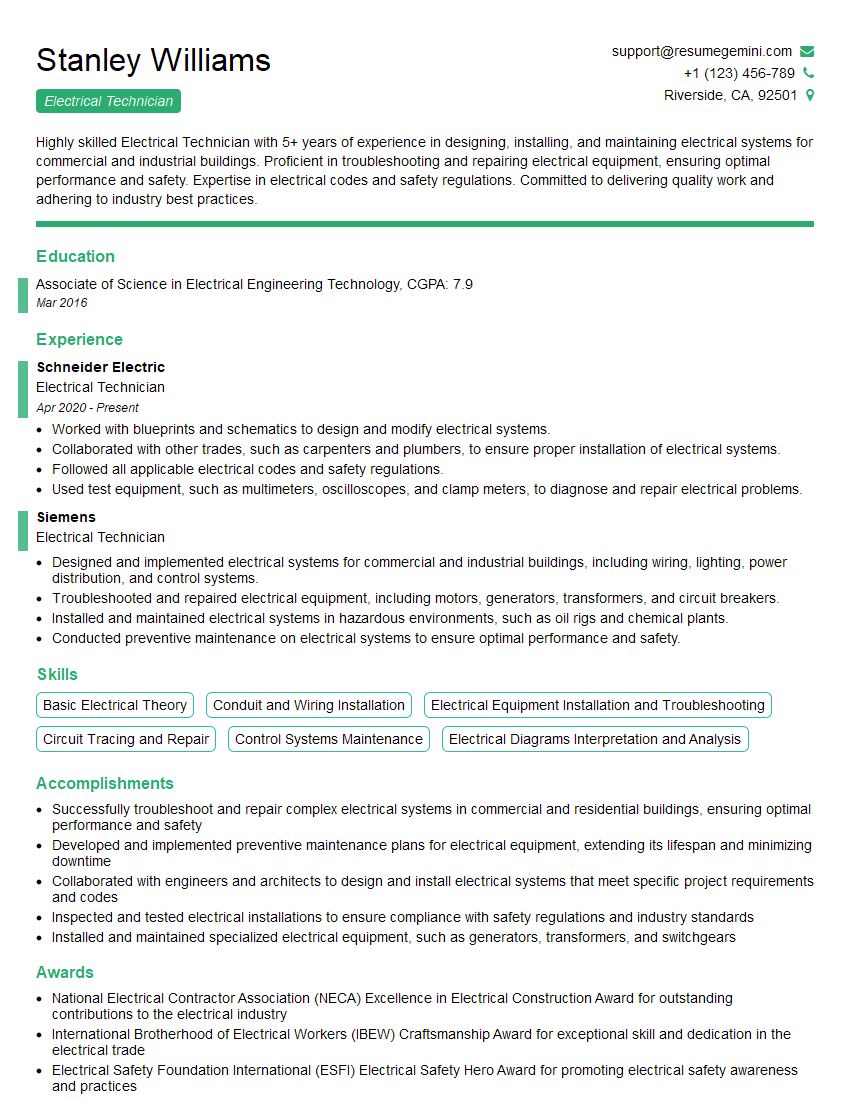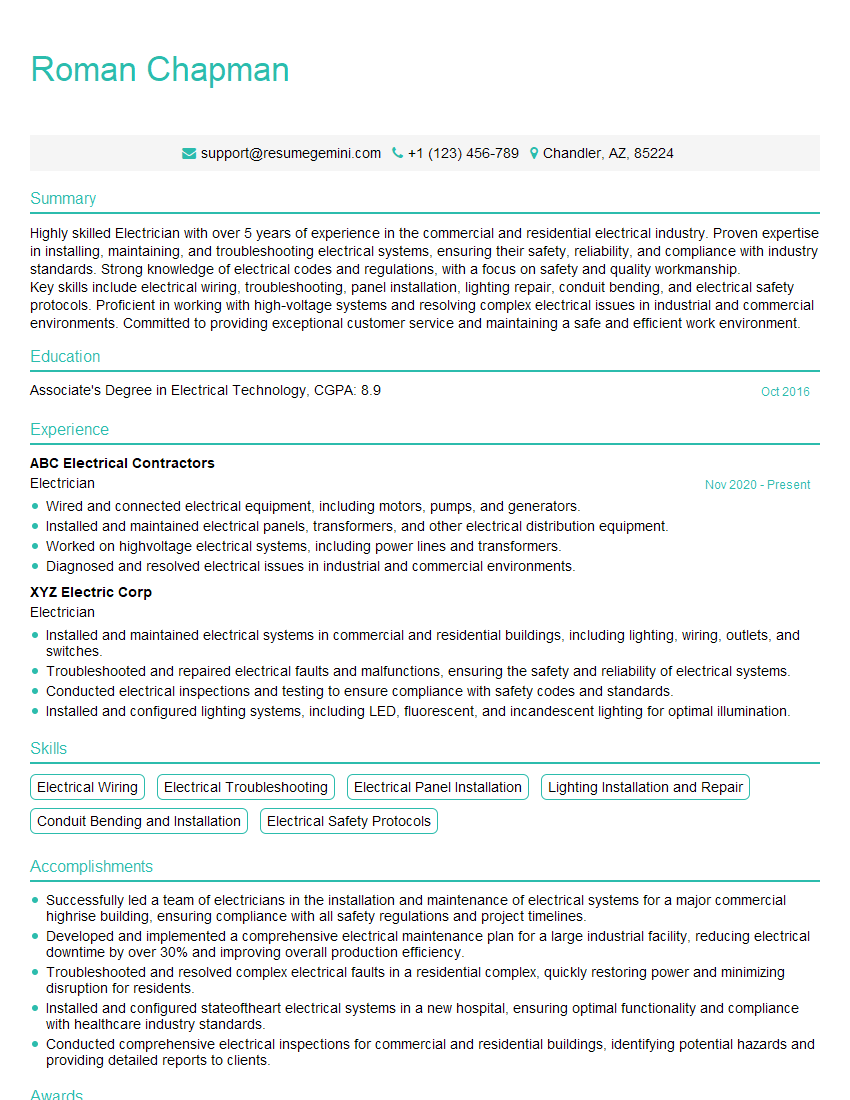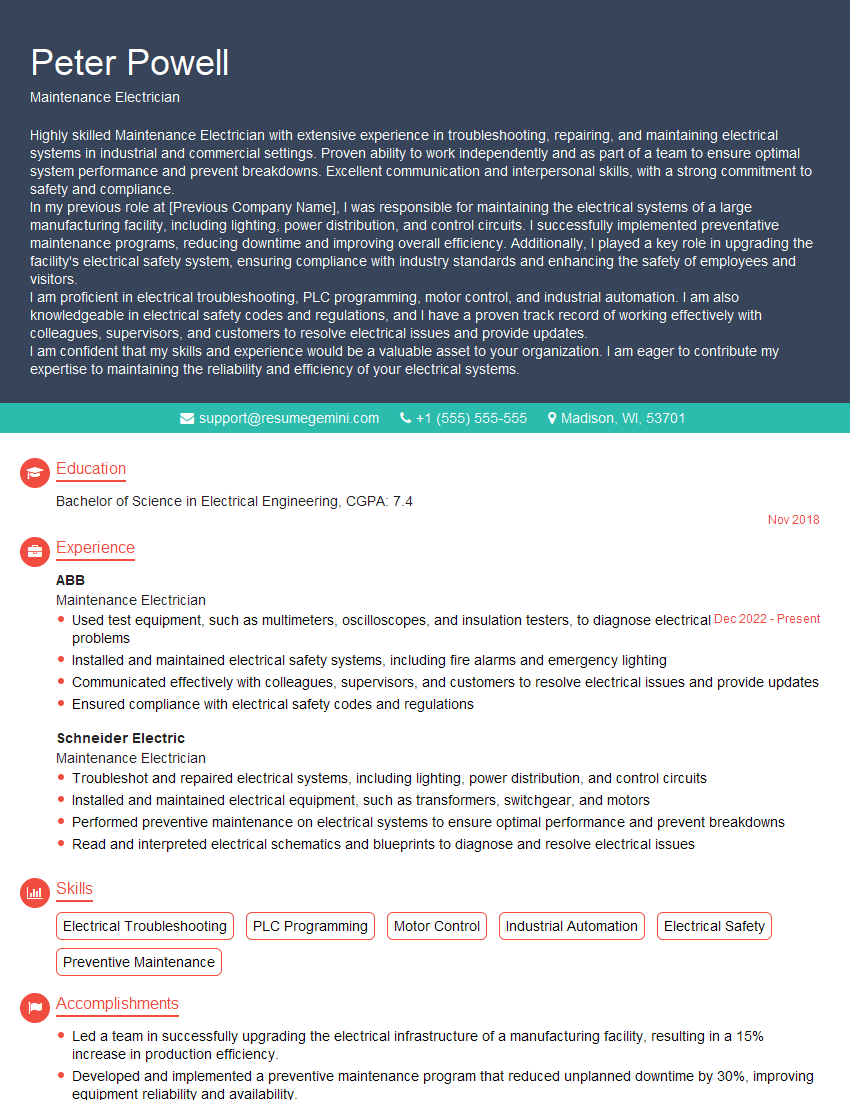Feeling uncertain about what to expect in your upcoming interview? We’ve got you covered! This blog highlights the most important Electrical Systems (AC/DC) interview questions and provides actionable advice to help you stand out as the ideal candidate. Let’s pave the way for your success.
Questions Asked in Electrical Systems (AC/DC) Interview
Q 1. Explain the difference between AC and DC current.
The fundamental difference between AC (Alternating Current) and DC (Direct Current) lies in the direction of electron flow. In DC, electrons flow consistently in one direction, like a river flowing downstream. This results in a constant voltage and current. In AC, the electron flow periodically reverses direction, oscillating back and forth like a pendulum. This creates a voltage and current that vary sinusoidally over time.
Think of it like this: DC is like a battery providing a steady power source, while AC is like the power coming from your wall outlet, constantly changing direction.
Q 2. What are the advantages and disadvantages of AC and DC systems?
AC Advantages:
- Efficient long-distance transmission: AC voltage can be easily stepped up (increased) using transformers for efficient long-distance transmission, minimizing power loss. This is why AC is the standard for electricity grids.
- Easy voltage transformation: Transformers allow for convenient voltage changes, adapting to different needs (high voltage for transmission, lower voltage for household use).
- Relatively simpler generation: AC generators are generally less complex to construct than DC generators of comparable power.
AC Disadvantages:
- Higher energy losses due to skin effect: At high frequencies, current tends to flow near the surface of conductors, increasing resistance and loss.
- More complex safety measures: The fluctuating nature of AC requires more stringent safety measures due to the potential for arcing and shocks.
DC Advantages:
- Easier to store: DC energy can be stored easily in batteries, making it suitable for portable devices and backup systems.
- No skin effect: DC current doesn’t experience the skin effect, resulting in lower transmission losses, especially over shorter distances.
- Suitable for certain applications: DC is essential for electronics and many industrial processes.
DC Disadvantages:
- Inefficient long-distance transmission: Stepping up DC voltage is less efficient and more complex than with AC.
- Limited voltage adjustment: Voltage adjustments are generally more difficult than in AC systems.
Q 3. Describe the principles of transformers.
Transformers operate on the principle of electromagnetic induction. They consist of two coils of wire, the primary and secondary coils, wound around a common ferromagnetic core. When an AC current flows through the primary coil, it creates a changing magnetic field within the core. This changing magnetic field, in turn, induces a voltage in the secondary coil. The ratio of the number of turns in the primary and secondary coils determines the voltage transformation.
If the secondary coil has more turns than the primary, the voltage is stepped up (increased). Conversely, if the secondary coil has fewer turns, the voltage is stepped down (decreased). The power remains approximately constant (ignoring losses), so a step-up in voltage results in a corresponding step-down in current, and vice-versa. This is crucial for efficient power transmission and distribution.
Example: A step-down transformer in a power supply unit might take 240V AC from the mains and reduce it to 12V AC for electronic components.
Q 4. How does a three-phase power system work?
A three-phase power system uses three separate AC waveforms, each 120 degrees out of phase with each other. These three phases are generated by a single alternator or generator. Instead of one single sine wave, it’s three sine waves offset from each other. This configuration offers several advantages over single-phase systems.
Advantages:
- Higher power capacity: For the same conductor size, a three-phase system can transmit significantly more power than a single-phase system.
- Smoother power delivery: The combined effect of the three phases results in a more constant power output with less fluctuation compared to single-phase systems.
- Efficient motors: Three-phase AC motors are more efficient and have a higher power-to-weight ratio than single-phase motors, making them suitable for heavy-duty applications.
How it works: The three phases are generated simultaneously and transmitted along three separate conductors (plus a neutral wire in some configurations). The phases can be connected in either a star (wye) or delta configuration, influencing the voltage and current relationships.
Q 5. Explain the concept of power factor and its importance.
Power factor (PF) is the ratio of real power (used to perform actual work) to apparent power (total power supplied). It is a measure of how efficiently electrical power is used in an AC circuit. A power factor of 1 (or 100%) indicates that all the power supplied is being used for work. A lower power factor indicates that some power is being lost due to reactive loads.
Importance:
- Reduced energy costs: A low power factor leads to higher energy consumption and increased electricity bills. Utilities often penalize consumers with poor power factors.
- Improved system efficiency: A high power factor enhances the efficiency of the entire electrical system, reducing transmission and distribution losses.
- Increased capacity: Improving the power factor allows the existing electrical system to handle a larger power load without significant upgrades.
Improving Power Factor: Methods for improving the power factor include using power factor correction capacitors to compensate for reactive loads.
Q 6. What are different types of AC motors and their applications?
There are various types of AC motors, each suitable for different applications. Here are a few examples:
- Induction Motors: These are the most common type of AC motor, simple and robust. They are widely used in industrial applications, fans, pumps, and compressors.
- Synchronous Motors: These motors run at a constant speed synchronized with the AC supply frequency. They are used in applications requiring precise speed control, such as clocks and some industrial machinery.
- Stepper Motors: These motors rotate in discrete steps, controlled by electrical pulses. They are commonly found in printers, robotics, and precision positioning systems.
- Universal Motors: These motors can operate on both AC and DC supplies. They are often used in household appliances like blenders and vacuum cleaners.
The choice of motor depends on factors like required speed, torque, efficiency, cost, and operating environment.
Q 7. Describe the working principle of a DC motor.
DC motors operate on the principle of electromagnetic interaction between a magnetic field and current-carrying conductors. The motor has a rotor (armature) with windings carrying current and a stator (field magnets) producing a magnetic field. The interaction between the magnetic fields of the rotor and stator generates a torque that causes the rotor to rotate.
When current flows through the rotor windings, it creates its own magnetic field. The interaction between this magnetic field and the stator’s magnetic field causes a force to act on the rotor windings, leading to rotation. The direction of rotation can be changed by reversing the direction of either the rotor current or the stator magnetic field.
Different types of DC motors, such as brushed and brushless motors, exist, with variations in their construction and control mechanisms. Brushed motors use brushes to transfer current to the rotor, while brushless motors use electronic commutation for greater efficiency and longevity. They are used in applications such as electric vehicles, robotics and power tools.
Q 8. Explain the concept of impedance in AC circuits.
Impedance in AC circuits is the overall opposition to the flow of alternating current. Unlike resistance in DC circuits, which only considers the opposition due to the material’s properties, impedance in AC circuits also accounts for the effects of capacitance and inductance. Think of it as the AC equivalent of resistance. It’s measured in ohms (Ω) and is a complex number, comprising a real part (resistance) and an imaginary part (reactance).
The reactance component arises from the energy storage properties of capacitors and inductors. Capacitors oppose changes in voltage, while inductors oppose changes in current. This opposition varies with frequency; higher frequencies encounter more opposition from inductors and less from capacitors.
We represent impedance (Z) using the formula: Z = R + jX, where R is resistance, X is reactance (XL – XC), and j is the imaginary unit (√-1). XL = 2πfL (inductive reactance) and XC = 1/(2πfC) (capacitive reactance), where f is frequency, L is inductance, and C is capacitance.
Example: Consider a circuit with a 100Ω resistor, a 10mH inductor, and a 1µF capacitor at 50Hz. Calculating the reactances: XL = 2π(50)(0.01) ≈ 3.14Ω and XC = 1/(2π(50)(10^-6)) ≈ 3183Ω. The impedance would then be: Z = 100 + j(3.14 - 3183) = 100 - j3180Ω. The magnitude of Z (|Z|) gives the overall impedance.
Q 9. How do you calculate the voltage drop across a resistor?
The voltage drop across a resistor is calculated using Ohm’s Law: V = IR, where V is the voltage drop (in volts), I is the current flowing through the resistor (in amperes), and R is the resistance of the resistor (in ohms).
This is a fundamental law in electrical engineering. It states that the voltage across a resistor is directly proportional to the current flowing through it. The proportionality constant is the resistance. A higher resistance will lead to a larger voltage drop for the same current.
Example: If a current of 2A flows through a 5Ω resistor, the voltage drop across the resistor is V = 2A * 5Ω = 10V.
Q 10. What is Kirchhoff’s voltage law and current law?
Kirchhoff’s laws are fundamental to circuit analysis. They provide a systematic way to solve for unknown voltages and currents in complex circuits.
Kirchhoff’s Voltage Law (KVL): The sum of the voltages around any closed loop in a circuit is zero. This reflects the conservation of energy; the energy supplied by sources must equal the energy consumed by components in a loop. Think of it like a roller coaster track – the total height change completing a full circuit is zero.
Kirchhoff’s Current Law (KCL): The sum of currents entering a node (junction) in a circuit equals the sum of currents leaving that node. This reflects the conservation of charge; charge cannot accumulate at a node. Imagine water pipes meeting – the total inflow must equal the total outflow.
Q 11. Explain the use of capacitors and inductors in AC circuits.
Capacitors and inductors play crucial roles in AC circuits, primarily due to their ability to store and release energy.
Capacitors: In AC circuits, capacitors allow current to flow ‘through’ them even though they don’t conduct direct current. They achieve this by charging and discharging repeatedly as the AC voltage changes. The current is proportional to the rate of change of voltage (high frequency = high current). They are frequently used for filtering, energy storage in power supplies, and coupling/decoupling stages.
Inductors: Inductors oppose changes in current. They store energy in a magnetic field. The voltage across an inductor is proportional to the rate of change of current (high frequency = high voltage). They are used in filters, energy storage in power supplies, and inductors are used in many applications like transformers, motors, and sensors.
The interplay of capacitors and inductors, leading to resonant circuits, is fundamental in many applications, including tuned filters and oscillators.
Q 12. Describe different types of electrical protective devices.
Several protective devices safeguard electrical systems from overcurrents, short circuits, and voltage surges:
- Fuses: A simple, inexpensive device that melts and breaks the circuit when excessive current flows.
- Circuit Breakers: Automatically interrupt the circuit when a fault occurs (explained in more detail below).
- Surge Arresters/Surge Protection Devices (SPDs): Protect against voltage spikes and surges, diverting excessive energy to ground.
- Ground Fault Circuit Interrupters (GFCIs): Detect imbalances in current flow, protecting against electric shocks.
- Thermal Relays: These devices protect motors from overheating due to overload.
The choice of protective device depends on the specific application and the nature of the potential hazards.
Q 13. How do circuit breakers work?
Circuit breakers are electromechanical switches that automatically interrupt a circuit when an overcurrent or fault occurs. They offer several advantages over fuses, including the ability to be reset and reused.
There are various types, but most commonly utilize either a thermal or magnetic mechanism, or a combination thereof.
Thermal mechanism: A bimetallic strip heats up when excessive current flows, causing it to bend and trip the breaker.
Magnetic mechanism: An electromagnet creates a magnetic field when a high current flows, causing a plunger to be activated and trip the breaker. This mechanism is faster and responds to higher fault currents more effectively.
Some circuit breakers incorporate both mechanisms to provide protection against both sustained overloads and fast short circuits.
Q 14. What is grounding and why is it important?
Grounding, or earthing, connects a part of an electrical system to the earth. This connection provides a low-impedance path for fault currents to flow to the ground, protecting people and equipment.
Importance:
- Safety: If a fault occurs (e.g., a live wire touches the chassis of an appliance), grounding provides a path for the fault current to flow to the ground, preventing a dangerous shock to anyone who touches the appliance.
- Equipment Protection: Grounding reduces voltage surges and helps protect equipment from damage due to lightning strikes or other transient events.
- Noise Reduction: Grounding can help reduce noise in sensitive electronic circuits.
Proper grounding is essential for safety and reliable operation of any electrical system. Improper grounding can lead to dangerous situations and equipment damage.
Q 15. Explain the concept of earthing and its significance.
Earthing, also known as grounding, is the process of connecting electrical equipment or systems to the earth. It provides a low-resistance path for fault currents to flow to the ground, preventing dangerous voltage buildup and protecting people and equipment from electrical shocks.
Its significance is paramount for safety. Imagine a faulty appliance with a live wire touching the metal casing. Without earthing, anyone touching the casing would receive a potentially lethal shock. Earthing provides a safe escape route for the current, ensuring the casing remains at ground potential (close to zero volts).
In practical terms, earthing is achieved using a conductive path, typically a copper wire, connected to a grounding electrode driven deep into the earth. This electrode, often a rod or a plate, provides a vast reservoir for dissipating fault currents.
- Safety: Prevents electric shock by providing a low-resistance path for fault currents.
- Equipment Protection: Reduces the risk of equipment damage due to overvoltage.
- Lightning Protection: Provides a safe path for lightning strikes to ground, safeguarding buildings and equipment.
Career Expert Tips:
- Ace those interviews! Prepare effectively by reviewing the Top 50 Most Common Interview Questions on ResumeGemini.
- Navigate your job search with confidence! Explore a wide range of Career Tips on ResumeGemini. Learn about common challenges and recommendations to overcome them.
- Craft the perfect resume! Master the Art of Resume Writing with ResumeGemini’s guide. Showcase your unique qualifications and achievements effectively.
- Don’t miss out on holiday savings! Build your dream resume with ResumeGemini’s ATS optimized templates.
Q 16. Describe different types of wiring systems.
Wiring systems are categorized based on their installation methods and the type of protection they offer. The choice of system depends on factors such as building type, load requirements, and safety regulations.
- Concealed Wiring: Wires are hidden within walls, floors, or ceilings, offering a cleaner aesthetic. This is common in residential and commercial buildings. Examples include wiring within conduit (metal pipes) or within walls using armored cables.
- Surface Wiring: Wires are run along the surface of walls or ceilings, often using plastic trunking or cleats. This is a simpler and quicker installation method, often used in temporary setups or renovations.
- Open Wiring: Wires are run exposed, typically using insulators and supports. This is less common in modern buildings due to safety and aesthetic considerations, but might still be seen in industrial settings.
Furthermore, systems can be classified based on the number of wires (single-phase, three-phase), the type of earthing (TN-S, TT, IT systems), and the voltage levels.
Consider a large industrial facility. They’ll likely employ a three-phase system with concealed wiring within conduit for reliability and safety. In contrast, a small office might use a single-phase system with surface wiring in plastic trunking for ease of installation and cost-effectiveness.
Q 17. How do you troubleshoot a faulty electrical circuit?
Troubleshooting a faulty electrical circuit requires a systematic approach. Safety is paramount; always disconnect power before starting any work. Here’s a step-by-step process:
- Visual Inspection: Check for any visible damage to wires, connections, or components (burnt marks, loose connections, damaged insulation).
- Test Voltage: Use a non-contact voltage tester to confirm power is off at the circuit breaker or fuse box. Then check for voltage at the suspected faulty area using a multimeter to confirm if the voltage is present.
- Check Circuit Breaker/Fuse: Ensure the circuit breaker isn’t tripped or the fuse isn’t blown. Replace the fuse if necessary, but investigate the cause of the blown fuse before re-energizing the circuit.
- Continuity Testing: Use a multimeter to test the continuity of the wiring. A low resistance indicates a good connection, while a high resistance or an open circuit indicates a break in the wire.
- Load Testing: If the circuit includes multiple components, isolate each one to identify the faulty element.
- Component Testing: Test individual components (switches, outlets, lights) with a multimeter to check for shorts or open circuits.
- Advanced Techniques: For complex circuits or persistent faults, specialized tools such as clamp meters and insulation testers might be required.
Example: Let’s say a lighting circuit is not working. You would first check the breaker/fuse, then visually inspect the wiring and switches, and finally test the continuity of the wires and the light fixture itself using a multimeter.
Q 18. Explain the safety precautions while working with high voltage systems.
Working with high-voltage systems poses significant risks of electric shock, burns, and arc flash. Stringent safety precautions are essential:
- Lockout/Tagout (LOTO): Always use LOTO procedures to de-energize and isolate the equipment before working on it. This involves locking out the circuit breaker and tagging it to prevent accidental re-energization.
- Personal Protective Equipment (PPE): Wear appropriate PPE, including insulated gloves, safety glasses, arc-flash suits (depending on voltage level), and safety shoes.
- Proper Training: Only trained and qualified personnel should work on high-voltage systems. Training should cover safety procedures, hazard identification, and the use of appropriate equipment.
- Grounding and Bonding: Ensure the system is properly grounded and bonded to minimize the risk of voltage buildup.
- Work Permits: Obtain necessary work permits before commencing any work on high-voltage systems. This ensures that all safety precautions are in place.
- Emergency Response Plan: Be prepared for emergencies by having a clearly defined emergency response plan in place.
Ignoring these precautions can lead to severe injury or death. Safety should always be the top priority when working with high-voltage systems.
Q 19. What are the common causes of power outages?
Power outages can stem from various causes, broadly categorized as:
- Equipment Failures: Faults in transformers, power lines, generators, or other equipment can cause outages. This could be due to wear and tear, overheating, or natural disasters.
- Overload: Excessive demand on the power grid can lead to outages. This is especially common during heat waves when air conditioners consume a significant amount of power.
- Natural Disasters: Storms, floods, earthquakes, and wildfires can damage power lines and infrastructure, leading to widespread outages.
- Human Error: Accidental damage to power lines during construction or maintenance, or mistakes during system operation, can cause outages.
- Cyberattacks: While less common, cyberattacks targeting critical infrastructure can also cause power outages.
For example, a severe thunderstorm can down power lines, while a faulty transformer may cause a localized outage. Understanding the cause is crucial for effective restoration and preventative measures.
Q 20. What are harmonic distortions and how to mitigate them?
Harmonic distortions are non-sinusoidal waves added to the pure sinusoidal waveform of the AC power supply. These distortions are caused by non-linear loads (e.g., rectifiers in computers and variable speed drives). They generate harmonic currents that flow back into the power system, leading to increased heating in equipment, decreased efficiency, and potential equipment failure.
Mitigation strategies include:
- Active Filters: These devices inject currents to cancel out the harmonic currents, improving power quality.
- Passive Filters: These use capacitors and inductors to absorb harmonic currents, but they are less effective than active filters and can only mitigate certain harmonics.
- Harmonic Impedance Reduction: Using power factor correction capacitors can reduce the harmonic impedance of the system, making it less susceptible to harmonic currents.
- Load Balancing: Distributing non-linear loads evenly across the system can minimize harmonic distortion.
- Proper Load Selection: Choosing equipment with low harmonic generation reduces the overall harmonic distortion.
For instance, a factory with numerous variable frequency drives (VFDs) would benefit significantly from installing active harmonic filters to protect its equipment and improve power quality.
Q 21. Explain the concept of power quality.
Power quality refers to the consistency and stability of the electrical power supply. It encompasses various parameters affecting the performance and reliability of electrical equipment.
Key aspects of power quality include:
- Voltage Stability: Maintaining a consistent voltage level within acceptable limits. Fluctuations in voltage can damage equipment and affect its performance.
- Frequency Stability: Keeping the frequency of the AC power supply stable at the nominal value (e.g., 50 Hz or 60 Hz). Deviations can lead to malfunctioning equipment.
- Harmonic Distortion: Minimizing the presence of harmonic currents that can cause overheating, equipment malfunction, and decreased efficiency (as discussed previously).
- Transient Disturbances: Preventing short-duration voltage spikes, dips, or surges that can damage sensitive equipment.
- Power Factor Correction: Ensuring a high power factor to improve the efficiency of the power system.
High power quality is essential for industries like healthcare, data centers, and manufacturing, where equipment downtime can be costly. It ensures smooth and reliable operation of sensitive equipment and maximizes operational efficiency.
Q 22. How do you perform a short-circuit calculation?
Short-circuit calculations determine the maximum current flow during a fault. It’s crucial for designing protective devices like circuit breakers and fuses, ensuring they can handle the fault current without damage. We use the principles of Ohm’s law and Kirchhoff’s laws, along with impedance calculations, to model the power system’s response to a short circuit.
The process typically involves:
- System Modeling: Representing the power system as a network of impedances (resistance and reactance) using a single-line diagram.
- Fault Location Identification: Determining the point of the short circuit (e.g., at a busbar, between phases, or a phase-to-ground fault).
- Fault Impedance Calculation: Calculating the total impedance seen by the fault current, considering the source impedance, the impedance of transmission lines, transformers, and any other equipment in the path.
- Current Calculation: Applying Ohm’s law (I = V/Z) to calculate the short-circuit current. V represents the pre-fault voltage, and Z is the total impedance calculated in the previous step. Remember that impedance is a complex number, so we often work with phasors for AC systems.
- Verification and Validation: Comparing the calculated fault current with the ratings of protective devices to ensure they can interrupt the fault current safely. Software tools significantly simplify this process.
Example: Imagine a simple system with a 10kV source, a 0.1+j0.5 ohm transformer impedance, and a 0.2+j1 ohm feeder impedance. A bolted three-phase short circuit occurs at the end of the feeder. The total impedance (Z) is 0.3+j1.5 ohm. Applying Ohm’s Law (phasor form is necessary in practice), we can find the short circuit current.
I = V/Z = 10000 / (0.3 + j1.5) ≈ 6626 ∠-78.7° AmpsThis calculation provides the magnitude and angle of the fault current, critical for device selection. More complex scenarios require sophisticated software like ETAP or PSCAD to handle numerous branches and different types of faults.
Q 23. Describe the different types of relays used in power systems.
Relays are the ‘nervous system’ of power systems, detecting faults and initiating protective actions. They come in various types, each designed for specific applications:
- Overcurrent Relays: These are the most common, tripping when current exceeds a preset threshold. They can be instantaneous or time-delayed, allowing coordination between relays at different locations to isolate only the faulted section.
- Differential Relays: These compare currents entering and leaving a protected zone (e.g., a transformer or generator). A significant difference indicates an internal fault.
- Distance Relays: These measure the impedance to the fault location and trip if it falls within a defined zone. They are particularly useful for long transmission lines.
- Ground Fault Relays: These detect ground faults, critical for safety and system integrity. They can be sensitive enough to detect small ground currents.
- Overvoltage/Undervoltage Relays: These protect against abnormal voltage levels.
- Power Swing Relays: These differentiate between actual faults and temporary power swings during system disturbances. They prevent unnecessary tripping during transient conditions.
The selection of a relay depends on the specific application, the type of equipment being protected, and the overall system design. They ensure the safety and reliability of the power system by quickly isolating faults and minimizing damage.
Q 24. Explain the concept of fault current and its calculation.
Fault current is the excessive current flowing during a short circuit or ground fault. It’s a significant concern because it can damage equipment, cause fires, and pose safety risks. Calculating fault current is crucial for designing protective systems and ensuring safety.
Calculation involves:
- System Impedance: Determine the total impedance (resistance and reactance) of the circuit from the source to the fault point. This includes the source impedance, transformer impedance, line impedance, and any other impedance in the path.
- Source Voltage: The voltage at the source supplying the faulted circuit.
- Fault Type: The type of fault (e.g., three-phase, single-line-to-ground, etc.) influences the calculation as different types have different impedance characteristics. For example, a single-line to ground fault has a different impedance path compared to a three-phase fault.
- Ohm’s Law Application: Once you determine the source voltage (V) and total impedance (Z), apply Ohm’s law (I = V/Z) to calculate the fault current (I). The impedance is a complex number (has a real and imaginary part for AC systems).
Software Tools: Specialized software packages simplify these calculations for complex power systems, providing detailed fault current analyses for various fault scenarios. These tools account for the complex nature of power systems, incorporating impedance data from various sources and considering different fault types.
Example: A simplified calculation would involve dividing the pre-fault voltage at the fault location by the total impedance at that point. However, accurate results for large power systems require dedicated software solutions.
Q 25. What are the different types of electrical testing equipment?
Electrical testing equipment is essential for ensuring the safety and proper functioning of electrical systems. Some common types include:
- Multimeters: Used for measuring voltage, current, and resistance. Digital multimeters offer high accuracy and versatility.
- Clamp Meters: Measure current without breaking the circuit, making them ideal for in-service measurements.
- Meggers (Megohmmeters): Test insulation resistance, crucial for detecting potential ground faults and ensuring electrical safety.
- Insulation Testers: Provide detailed insulation resistance tests, often with variable voltage settings for different applications.
- Hi-Pot Testers (High-Potential Testers): Apply a high voltage to test the dielectric strength of insulation systems in cables and equipment.
- Power Quality Analyzers: Monitor voltage sags, surges, and harmonics to improve the quality of power supply.
- Loop Testers: Measure the impedance of the protective earthing loop to ensure safety in electrical installations.
The choice of equipment depends on the specific testing needs and the complexity of the electrical system being examined. Proper use of these instruments and understanding their limitations is crucial for accurate and reliable results. Always follow safety procedures when working with electrical testing equipment.
Q 26. How do you interpret electrical schematics and drawings?
Interpreting electrical schematics and drawings requires a solid understanding of electrical symbols and conventions. These drawings provide a visual representation of the electrical system’s components and their interconnections. My approach involves:
- Symbol Recognition: Familiarity with the standard symbols for different components (switches, breakers, transformers, motors, etc.) is crucial. Each symbol represents a specific function in the system.
- Tracing Paths: Following the lines and connections to understand how power flows through the system. This helps understand the sequence of operations.
- Component Identification: Identify the various components in the diagram, including their ratings and specifications. This information is vital for system analysis and troubleshooting.
- Understanding Logic: For control systems, understanding the logic behind the connections, particularly relay logic, is essential to fully grasp the operational sequence.
- Reference Documentation: Consulting relevant documentation such as equipment manuals and specifications aids in interpreting the details.
Example: A simple schematic may show the connection of a motor to a power supply via a circuit breaker. The diagram would clearly indicate the components, voltage ratings, and protection strategies. Understanding this diagram allows you to trace power flow and identify potential failure points.
Q 27. Explain your experience with different types of electrical software.
My experience encompasses several electrical software packages, each offering specific functionalities for analysis and design:
- ETAP (Electrical Transient Analyzer Program): This is a widely used software package for power system analysis, fault current calculations, protection coordination studies, and arc flash hazard analysis. I have extensive experience creating models of complex power systems, running simulations, and generating comprehensive reports.
- PSCAD (Power Systems Computer-Aided Design): PSCAD is particularly useful for modeling transient events and simulating various fault conditions in power systems. This allows for detailed analysis of system stability and protection system performance.
- AutoCAD Electrical: I’m proficient in using AutoCAD Electrical for designing and documenting electrical systems, including creating schematics, panel layouts, and wiring diagrams.
- SKM PowerTools: This software assists in relay coordination studies and helps ensure that protective devices operate correctly in a coordinated manner during fault conditions.
The choice of software depends on the project’s specific needs. For example, ETAP might be the best choice for comprehensive power system studies, while AutoCAD Electrical is more suitable for detailed design and documentation. My proficiency in these tools enables efficient and accurate analysis and design of electrical systems.
Q 28. Describe a challenging electrical problem you solved and how you approached it.
During a project involving the upgrade of a large industrial facility’s electrical distribution system, we encountered unexpected high harmonic distortion levels. The existing system was struggling to handle the increased load from new, highly efficient variable-speed drives (VSDs). This resulted in overheating of some transformers and nuisance tripping of protective devices.
My approach was systematic:
- Investigation and Data Collection: We used power quality analyzers to collect extensive data on voltage and current waveforms, identifying the significant harmonic distortion components.
- Root Cause Analysis: We determined that the high harmonic content generated by the VSDs was exceeding the capacity of the existing power system’s harmonic filtering capabilities.
- Solution Design: We proposed several solutions, including adding harmonic filters strategically throughout the system, upgrading existing transformers with better harmonic mitigation capabilities, and implementing active power filtering technologies.
- Simulation and Verification: Using ETAP, we simulated the proposed solutions to verify their effectiveness in reducing harmonic distortion and ensuring system stability.
- Implementation and Monitoring: We oversaw the implementation of the chosen solutions and subsequently monitored the system to confirm a significant reduction in harmonic distortion, improved transformer temperatures, and elimination of nuisance tripping.
This experience highlighted the importance of comprehensive power quality analysis and the use of simulation tools in designing robust and reliable electrical systems. It also reinforced the need to anticipate the impact of new technologies like VSDs on the existing power infrastructure.
Key Topics to Learn for Electrical Systems (AC/DC) Interview
- Fundamentals of AC and DC Circuits: Understand Ohm’s Law, Kirchhoff’s Laws, series and parallel circuits, and power calculations for both AC and DC systems. Consider exploring different circuit analysis techniques.
- AC Circuit Analysis: Master concepts like impedance, reactance, phasors, and power factor. Explore practical applications in power transmission and distribution systems.
- DC Circuit Analysis: Focus on topics like voltage dividers, current dividers, Thevenin and Norton theorems, and their applications in various DC circuits.
- Three-Phase Power Systems: Understand the fundamentals of three-phase systems, including wye and delta configurations, power calculations, and applications in industrial settings.
- Transformers: Learn about transformer principles, types (step-up, step-down), efficiency calculations, and their crucial role in power systems.
- Motors and Generators: Grasp the working principles of different types of AC and DC motors (e.g., induction motors, synchronous motors, DC brushed motors, DC brushless motors) and generators. Be prepared to discuss their applications and control methods.
- Power Electronics: Familiarize yourself with rectifiers, inverters, and other power electronic devices and their use in controlling AC and DC power. Understanding their role in renewable energy systems is beneficial.
- Instrumentation and Measurement: Understand various techniques and instruments used for measuring voltage, current, power, and other electrical parameters in AC and DC systems.
- Troubleshooting and Problem-Solving: Develop your analytical skills to diagnose faults and solve problems in electrical systems. Practice applying your knowledge to real-world scenarios.
- Safety Regulations and Practices: Demonstrate understanding of relevant safety standards and best practices for working with AC and DC electrical systems.
Next Steps
Mastering Electrical Systems (AC/DC) is crucial for career advancement in various engineering fields, offering opportunities in design, development, testing, and maintenance roles. A strong understanding of these concepts will significantly enhance your job prospects. To stand out, create an ATS-friendly resume that effectively highlights your skills and experience. ResumeGemini is a trusted resource to help you build a professional and impactful resume. We provide examples of resumes tailored to Electrical Systems (AC/DC) roles to guide you in crafting a compelling document that showcases your expertise.
Explore more articles
Users Rating of Our Blogs
Share Your Experience
We value your feedback! Please rate our content and share your thoughts (optional).
What Readers Say About Our Blog
There are no reviews yet. Be the first one to write one.

